While woodpeckers search for insects by spiraling up a tree, the nuthatch zig-zags down the trunk head-first. Foraging upside-down may seem unnatural to us but nuthatches have a knack for it.
Nuthatches don’t rely on their tail feathers like woodpeckers to prop themselves against the trunk while foraging for insects. Instead nuthatches have a large claw on their one backward-pointing toe that helps them keep a grip.
Why forage downward head-first instead of backing down the trunk? The different position from woodpeckers allows nuthatches to capitalize on insects and other invertebrates seen only from the upside-down viewpoint.
Nuthatches are in search of wood-boring beetle larvae, beetles, ants, caterpillars, stinkbugs, spiders, earwigs, wasps and other invertebrates, both in the summer and winter. They also supplement their diet with seeds and nuts especially from bird feeders and seeds they have cached.
With their unique trait of foraging upside-down, nuthatches aren’t in competition with other songbirds when they forage in mixed flocks. Nuthatches can often be seen foraging with chickadees, kinglets, woodpeckers, brown creepers or juncos depending on the species.
Three species of nuthatches can be seen in North Idaho: white-breasted nuthatch, red-breasted nuthatch and pygmy nuthatch. All three species have a short tail, large head and long beak.
In addition to the unique characteristic of foraging upside-down, each nuthatch has other unique traits.
The white-breasted nuthatch is the largest nuthatch in North America at 5.1 to 5.5 inches long and is the only nuthatch to have white coloration all the way around its eye.
On the other end of the spectrum are pygmy nuthatches at a mere 3.5 to 4.3 inches long–small by nuthatch standards. Pygmy nuthatches only weigh a third of an ounce– less than two big marshmallows!
The pygmy nuthatch’s small size makes surviving cold winter nights difficult. Consequently, pygmy nuthatches are the only bird to utilize three energy-saving mechanisms to survive the cold–they seek shelter in tree cavities, they huddle with other pygmy nuthatches (sometimes dozens together) and they let their body temperature drop into hypothermia.
Pygmy nuthatches are also unique by being one of the few North American songbirds to have nest helpers. About one-third of breeding pygmy nuthatches receive help from one to three male relatives (often their own sons from previous years) who help defend the nest and feed the incubating female and chicks.
Red-breasted nuthatches are one of the few non-woodpeckers to excavate their own nest cavities in solid wood. They often excavate in aspen trees because of the softer wood.
Around the nest hole entrance, red-breasted nuthatches plaster globules of conifer resin. The male surrounds the hole on the outside of the nest with resin while the female surrounds the hole entrance within the nest cavity. Scientists believe red-breasted nuthatches utilize the resin to keep predators and competitors out of their nest. To avoid the resin themselves, the nuthatches dive directly through the hole.
Even though each nuthatch is unique, they all share the same behavior that gave them their name– jamming large nuts into tree bark and hammering them with their sharp bill to “hatch” the nut. So when a nuthatch pauses on its way down the trunk, it may just be hatching a seed it had previously cached.

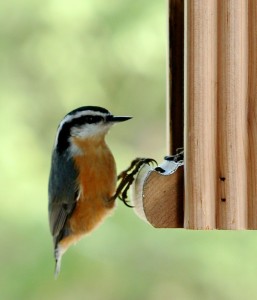
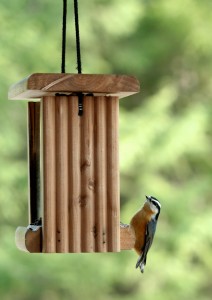
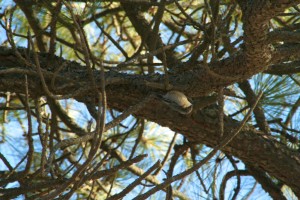
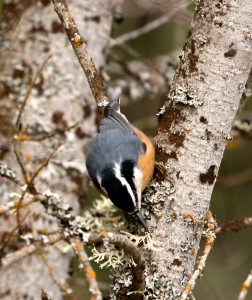
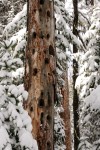
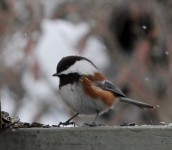
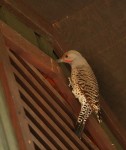
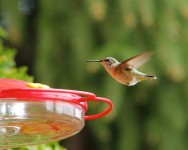
Thank you for the spectacular article on God’s nuthatches!
I loved the interesting article about nuthatches. I would like to know how do you attract them to your yard. Also, if you have information about Chickadees and do they stay all year in one place, and how to keep them coming back if they don’t. I live in Bonners Ferry on the northside. The other interesting thing I’ve learned about Chickadees is that when I use the app on my iPhone that has the calls and songs of Chickadees, they answer back. Everything in my yard can be quiet and I play that and immediately there is a choir of Chickadees singing. Some will even follow me down the street from tree to tree. Is that natural for them?
I’ll be looking forward to more articles about birds in our area. Thank you.
The nuthatches in my yard are attracted to the sunflower seeds and suet we set out in winter. I haven’t seen any nuthatches since we stopped feeding them a few weeks ago.
Your experience with the chickadees singing is interesting and something I’ll have to try! I’ll have to look for more information on chickadees.
Thank you!